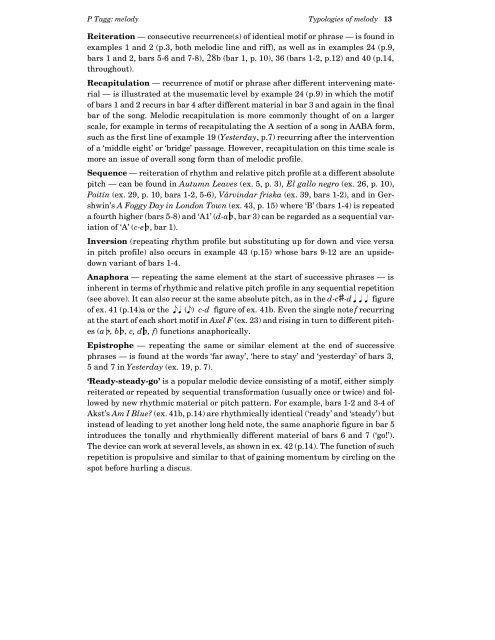Melody and Accompaniment - Philip Tagg
Melody and Accompaniment - Philip Tagg
Melody and Accompaniment - Philip Tagg
You also want an ePaper? Increase the reach of your titles
YUMPU automatically turns print PDFs into web optimized ePapers that Google loves.
P <strong>Tagg</strong>: melody Typologies of melody 13<br />
Reiteration — consecutive recurrence(s) of identical motif or phrase — is found in<br />
examples 1 <strong>and</strong> 2 (p.3, both melodic line <strong>and</strong> riff), as well as in examples 24 (p.9,<br />
bars 1 <strong>and</strong> 2, bars 5-6 <strong>and</strong> 7-8), 28b (bar 1, p. 10), 36 (bars 1-2, p.12) <strong>and</strong> 40 (p.14,<br />
throughout).<br />
Recapitulation — recurrence of motif or phrase after different intervening material<br />
— is illustrated at the musematic level by example 24 (p.9) in which the motif<br />
of bars 1 <strong>and</strong> 2 recurs in bar 4 after different material in bar 3 <strong>and</strong> again in the final<br />
bar of the song. Melodic recapitulation is more commonly thought of on a larger<br />
scale, for example in terms of recapitulating the A section of a song in AABA form,<br />
such as the first line of example 19 (Yesterday, p.7) recurring after the intervention<br />
of a ‘middle eight’ or ‘bridge’ passage. However, recapitulation on this time scale is<br />
more an issue of overall song form than of melodic profile.<br />
Sequence — reiteration of rhythm <strong>and</strong> relative pitch profile at a different absolute<br />
pitch — can be found in Autumn Leaves (ex. 5, p. 3), El gallo negro (ex. 26, p. 10),<br />
Poitín (ex. 29, p. 10, bars 1-2, 5-6), Vårvindar friska (ex. 39, bars 1-2), <strong>and</strong> in Gershwin’s<br />
A Foggy Day in London Town (ex. 43, p. 15) where ‘B’ (bars 1-4) is repeated<br />
a fourth higher (bars 5-8) <strong>and</strong> ‘A1’ (d-a$, bar 3) can be regarded as a sequential variation<br />
of ‘A’ (c-e$, bar 1).<br />
Inversion (repeating rhythm profile but substituting up for down <strong>and</strong> vice versa<br />
in pitch profile) also occurs in example 43 (p.15) whose bars 9-12 are an upsidedown<br />
variant of bars 1-4.<br />
Anaphora — repeating the same element at the start of successive phrases — is<br />
inherent in terms of rhythmic <strong>and</strong> relative pitch profile in any sequential repetition<br />
(see above). It can also recur at the same absolute pitch, as in the d-c#-d figure<br />
of ex. 41 (p.14)a or the () c-d figure of ex. 41b. Even the single note f recurring<br />
at the start of each short motif in Axel F (ex. 23) <strong>and</strong> rising in turn to different pitches<br />
(a$, b$, c, d$, f) functions anaphorically.<br />
Epistrophe — repeating the same or similar element at the end of successive<br />
phrases — is found at the words ‘far away’, ‘here to stay’ <strong>and</strong> ‘yesterday’ of bars 3,<br />
5 <strong>and</strong> 7 in Yesterday (ex. 19, p. 7).<br />
‘Ready-steady-go’ is a popular melodic device consisting of a motif, either simply<br />
reiterated or repeated by sequential transformation (usually once or twice) <strong>and</strong> followed<br />
by new rhythmic material or pitch pattern. For example, bars 1-2 <strong>and</strong> 3-4 of<br />
Akst’s Am I Blue? (ex. 41b, p.14) are rhythmically identical (‘ready’ <strong>and</strong> ‘steady’) but<br />
instead of leading to yet another long held note, the same anaphoric figure in bar 5<br />
introduces the tonally <strong>and</strong> rhythmically different material of bars 6 <strong>and</strong> 7 (‘go!’).<br />
The device can work at several levels, as shown in ex. 42 (p.14). The function of such<br />
repetition is propulsive <strong>and</strong> similar to that of gaining momentum by circling on the<br />
spot before hurling a discus.














